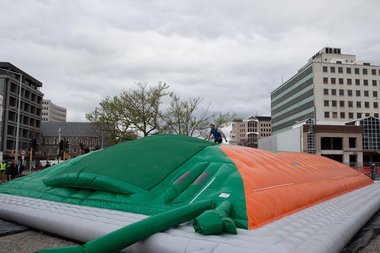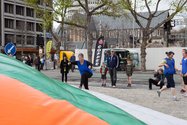John Hurrell – 11 October, 2013
The twitching ‘ground' seems to be like a form of earthquake, but maybe that is being too literal. It could be cathartic or some form of psychic innoculation (maybe all Cantabrians should have a go) but it also seems blackly comedic when yawning chasms suddenly appear in front of the runner. Implying a malicious, personally vindictive God, it has Biblical Old Testament overtones.
Christchurch
David Cross
Level Playing Field/Powerslide
Curated by Blair French
27 September - 9 November 2013
A vital element in SCAPE7, Level Playing Field/Powerslide, is an entertaining team sport invented by David Cross to go with his flat, biscuit shaped inflatable, set up on a cleared, earthquake demolition site in Gloucester Street, the old ‘Hays corner’. The pneumatic slab looks like a massive duvet covering a low mound. The sculpture / performance ‘happens’ when people use the prop as the crucial element in a game - when live kinetic energy is introduced.
In this event, competitors for each team play a twisted version of Barbador. One at a time, they seek points by running furiously across the bouncy top to the other side, while underneath the wobbly roof the opposing team try to make them fall over and roll off. The runners are aiming to dive through a covered shute so they can slide down, pop out onto the ground below, run back and finish the circuit - each point tallied by an electronic scoring board. There are six on each side and they keep going - each runner being tagged by his or her predecessor - until they run out of their allotted time.
The most successful teams seem to be the ones skilled at preventing the opposition making a clean break for the shute. Using straps and stirrups they can make the ‘ground’ drop, heave and convulse so it is impossible to proceed. They can’t see the runner directly above, though they can detect their clambering foot movements and anticipate their direction. So if they are good at group co-ordination the opposition can’t get traction.
It is a weird game because unless you peer into the ‘portholes’ on the side, you only see the solitary runners outdoors struggling on the skyline, not the opposing jerking and straining team-mates hidden underneath, yanking on straps. Of course the twitching ‘ground’ seems to be like a form of earthquake, but maybe that is too literal. It could be cathartic or some form of psychic innoculation (maybe all Cantabrians should have a go) but it also seems blackly comedic when yawning chasms suddenly appear in front of the runner. Implying a malicious, personally vindictive God, it has Biblical Old Testament overtones.
One curious detail - though I doubt the artist ever anticipated this reading - but because it looks like a low hillock, or an inverted saucer, it could be a tumulus, a tomb barrow. This seems to suggest some primal impulse to do with death, resurrection and maybe reincarnation, bodies diving into the earth headfirst only to emerge ‘birthed’ from a cave at the end so they can run back to the beginning. There’s the vague suggestion of some primal impulse, some fundamental recognition of ancient powers, going on with what is essential a landscape sculpture. Inflatable plastic and rubber it may be, but it has strong links to seventies ‘earth art.’
Even the idea of subterranean dwellers rascally changing the earth’s surface is intriguing. I like the fact that the inflatable’s colours are green and orange, as if grassy paddocks and clay banks, and the grey ring around the borders a band of river stones. Its kinetic lack of stability suggests the passing of time over huge periods. Geological changes over aeons, on fast forward.
In terms of perceptible ‘real’ time the electronic scoreboard is a crucial component of this game, for it cranks up the psychological pressure. We watch the allotted period diminish as each team tries to get the highest score.
When the compressed air is in the sculpture and human forms are making the springy kurgan come to life, Level Playing Field/Powerslide is a wonderful spectator diversion, one that deserves a wide following. Its surreal humour is a real bonus, part of successfully maintaining the competitive tension that all good sport (and art - with other art: something rarely stated) aspires to.
John Hurrell
Recent Comments
John Hurrell
I was very sorry to hear about this accident. http://www.stuff.co.nz/national/9264317/Artwork-injury-stalls-games Sorry for the man and his family, the artist and ...
John Hurrell
This is the first of an ongoing series of articles by different writers on SCAPE7.







 Advertising in this column
Advertising in this column Two Rooms presents a program of residencies and projects
Two Rooms presents a program of residencies and projects



This Discussion has 2 comments.
Comment
John Hurrell, 6:58 a.m. 11 October, 2013 #
This is the first of an ongoing series of articles by different writers on SCAPE7.
John Hurrell, 7:38 p.m. 11 October, 2013 #
I was very sorry to hear about this accident. http://www.stuff.co.nz/national/9264317/Artwork-injury-stalls-games
Sorry for the man and his family, the artist and the SCAPE team. Good though that SCAPE's internal review decided they have 'robust health and safety systems and process in place.'
http://scapebiennial.org.nz/powerslide
Participate
Register to Participate.
Sign in
Sign in to an existing account.